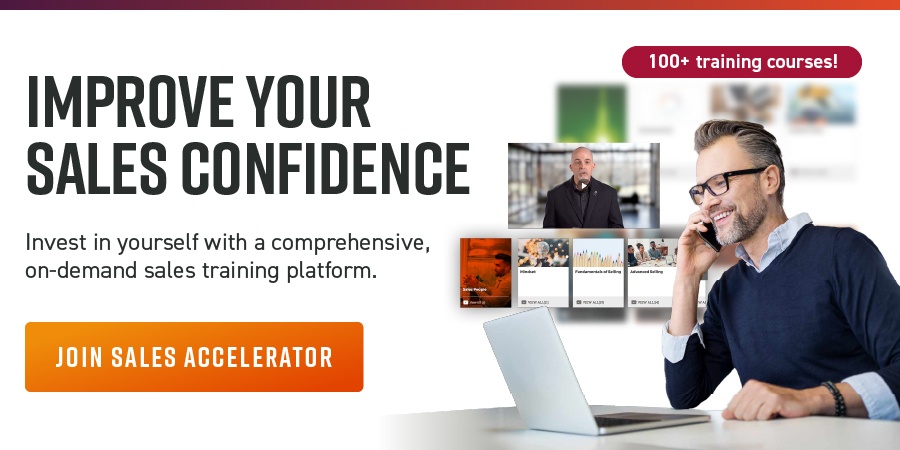Theodore Levitt, a marketing professor at Harvard Business School taught his students that people don’t buy drills; they buy quarter-inch holes. No one wants to buy a drill, they buy the outcome the drill provides them. Too many salespeople have been convinced that their solution is superior to that of their competition. Most companies have a solution that can produce the same outcome as their competitors.
Weak salespeople talk about their company. Average salespeople talk about their solution. Consultative salespeople talk about strategic outcomes. C-level stakeholders care little about your solution and are mainly interested in producing the strategic outcomes they need.
By discussing strategic outcomes, you can differentiate yourself in the sales conversation. It also allows you to position your solution by explaining how it will provide your client’s desired strategic outcomes.
See: How to Sell Strategic Outcomes
Strategic Outcomes: An Example
Let’s look at a simple example. No one wants to buy sales training. They buy the strategic outcome that results from the training. You can start to understand this approach by recognizing that no one wants to buy what you sell and, instead, identifying the strategic outcome they need.
Some people buy sales training because they want greater net new revenue. Others buy sales training because they need greater profitability. Still others buy sales training because they commit to developing their people and improving their team’s effectiveness. Those three strategic outcomes are followed by a longer list of other potential outcomes.
See: Leading Growth: The Proven Formula for Consistently Increasing Revenue
Going Forward in Reverse
In Elite Sales Strategies: A Guide to Being One-Up, Creating Value, and Becoming Truly Consultative, I suggested that you should not have to ask your clients about their problem or their pain points. You should have a list of the common problems and their implications for your clients.
Our B2B sales methodology would have you eliciting the strategic outcome, what we call Level 4 Value Creation. By establishing your client’s strategic outcomes as the foundation of your conversation, you can focus on what the client will need to do to achieve them. See Eat Their Lunch: Winning Customers Away from Your Competition for more on this approach.
If this seems backward, that is because the sales training and development industrial complex has convinced sales organizations they only need to identify a problem so they can position their solution as the answer. If you believe your client doesn’t want to buy your solution, you can move to a higher-level conversation about what they are buying and why it is a priority.
A List of Common Strategic Outcomes
Yesterday, a salesperson sent me an InMail to ask if I had experience with value propositions. He followed up with a question about the number of value propositions he might need.
Here is the rub: You have one value proposition for your solution. Unfortunately, the one-size-fits-all approach constrains your ability to speak to each of your client’s strategic outcomes. Let’s imagine your client asks you to print a letter, fold it into thirds, stuff it in an envelope, and send it to people between the ages 22 and 30. You explain how your solution will help the client send these letters. If you would prefer not to be treated as a commodity, you must move off your Level 3 outcomes and move to Level 4 by focusing on the strategic outcomes.
Level 4 looks beyond getting the letters sent and focuses on their impact on the client’s larger strategy. Is the client sending the letters to acquire new customers? Are they sending them to communicate a change that their customers need to know? Are they sending a promotion that will increase the lifetime value of their existing customers? You can improve your sales conversation by explaining how you can help your client with their strategic outcomes. This is the difference between being an order filler and being a strategic partner.
Your Position as an Expert and Authority
If you want your prospective clients to recognize that you are different from your competitors, the first thing you need to do is to have a better sales conversation than salespeople from other organizations. The shift from Level 3 execution to Level 4 strategic outcomes will position you as someone who understands what their clients are buying.
It helps to have business acumen when using this approach, but addressing the client’s strategic outcomes will cause you and your contacts to have a different and more valuable conversation.
This sales approach makes it easier to compel the changes your client will need to make to generate their desired outcomes. While they may not make changes in order to buy your solution, they are more likely to do so to reach an important outcome.
Why Ask Your Clients for Their Strategic Outcomes
By asking your prospective clients to disclose their strategic outcomes, you attach what you are selling to their priorities. C-level contacts and other decision-makers are already pursuing their goals. One reason your deals stall is because what you offer isn’t tied to your client’s priorities. By explaining how you can contribute to the ultimate outcome, you increase your ability to get your initiative funded.
In enterprise-level pursuits, this approach, when coupled with a set of value-creation strategies will help you create a preference to buy from you. Those who wonder why I am obsessed with business acumen, doing the reading, and becoming an expert and authority is because this is necessary to create value for your clients, all of whom are businesspeople. To succeed, look and sound like a businessperson.
Leaving this article, make a list of the strategic outcomes your clients are pursuing. This will allow you to tie what you sell to the strategic outcomes your clients need. You might also want to start developing talk tracks that explain how what you sell will ensure the client produces their strategic outcomes.









.jpg?width=768&height=994&name=salescall-planner-ebook-v3-1-cover%20(1).jpg)


